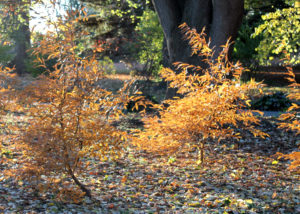Spicebush
* Common name: Spicebush
* Botanical name: Lindera benzoin
* What it is: A native flowering shrub that’s usually found in damp, wooded areas in the wild. It’s one of the first shrubs of the season to bloom, producing mildly fragrant little greenish-white flowers along the bare stems before the leaves emerge.
Fall foliage is yellow, and female spicebushes get small red fruits in fall when pollinated by a male. It’s a key plant for the spicebush swallowtail butterfly.
* Size: 6 to 8 feet tall and wide.
* Where to use: Does best in partly shaded or dappled-light settings, along eastern or northern foundations, and especially in woodland gardens. Grows in full shade, although not as densely and with more muted fall foliage. Also will tolerate full sun if kept damp. Competes well with tree roots.
* Care: Scatter a balanced organic granular fertilizer around base of the plant each March. Keep damp the first season or two until the roots establish, then water needed only during dry spells or if leaf edges begin to brown.
No need to prune unless plant is outgrowing the space, in which case spicebush is best pruned soon after flowers have finished blooming.
* Great partner: Trillium and woodland poppies are good native perennials that like the same damp, shady conditions. Golden sedge is a nice grassy-looking, color-matching partner.








